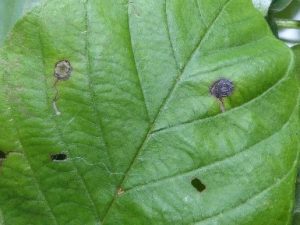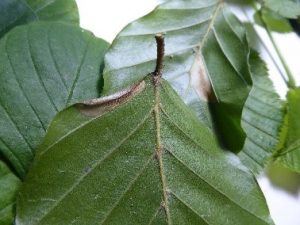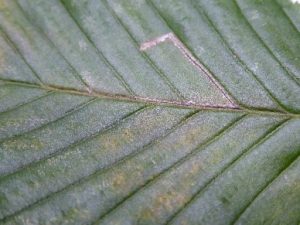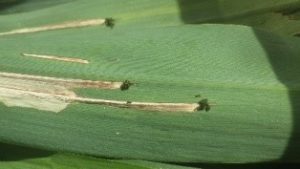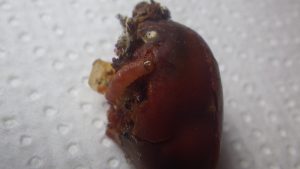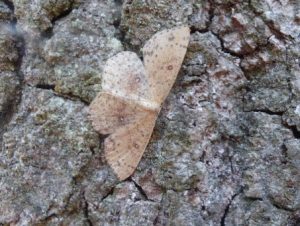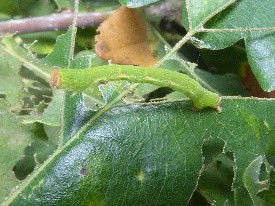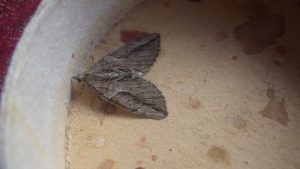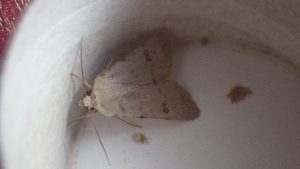Mike Halsey writes:
Mid-October, with the first frost of Autumn yesterday. Still plenty to see and do in the moth world, but fast approaching that time of the year when the microscope comes out in order to identify some of the (often tiny) specimens that were unidentified when they were seen over summer months. There are a number of features and organs not normally visible to the naked eye – or which can only be seen by dissecting the specimen – which can help in determining which family and genus a specimen belongs to. In fact there are a number of cases where two or more species are so similar that the identity of an individual can only be confirmed by dissection.
In the meantime, while there are still leaves on the trees, there’s lots to see around the pond, as many species leave signs of feeding that are effectively signatures. A colleague in Australia runs an Alpine ecology course for Uni students, and for 30 years has started each new course with a challenge to the students to find a mature Eucalyptus leaf without evidence of insect damage. He’s offered a case of beer to anyone who could bring an undamaged leaf, and still has the same case of beer he first offered 30 years ago!
Oaks in the UK are fairly similar, with undamaged leaves hard to find at this time of year. And the leaves of many other trees – birch, rowan, sallow and others – are covered in the evidence of insect use; mainly feeding, but also shelter. Caterpillars of larger moths will generally consume whole leaves or chunks of leaves, with the caterpillar itself remaining visible. Caterpillars of the smaller moths often feed internally, eating the tissue between the upper and lower epidermis of the leaf; by this time of year, some of these tiny caterpillars have finished eating, completed their development and left the shelter of the leaf, leaving a trail (‘mine’). In other cases, the caterpillar can still be seen inside the mine, by holding it up to a light source. Below are some leaves showing signs of moth larvae from around Fleet pond at the moment:
Leaf of Alder-Buckthorn with two larval mines of the tiny moth Bucculatrix frangutella
Leaves of Beech with larval mines of Phyllonorycter maestingella
Hornbeam leaf with a mine of Stigmella sp, probably S.microtheriella
Common reed (Phragmites) leaf with mines of Cosmopterix scribaiella, the lower picture showing the larva in the mine
Pictured below are what the adults of these 4 tiny, very beautiful moths look like:
| Bucculatrix frangutella | Phyllonorycter maestingella | Stigmella microtheriella | Cosmopterix scribaiella |
And larvae (caterpillars) don’t only eat leaves; practically all parts of growing plants are used (and a whole range of other things, including other insects, fungi and animal dung) and below is pictured a larva of Grapholita tenebrosana feeding on a rose hip.
In the light traps over the past few months, one of the exciting highlights among the larger moths has been the discovery of what seems to be a local colony of the False Mocha moth (pictured below), a species in serious decline and rarely seen nowadays. Two specimens were seen in Coldstream Marsh in August (the larva, pictured right, feeds on pedunculate oak, common around the edges of the marsh).
Finally, late summer and Autumn months are when large numbers of moths arrive in the UK having migrated from continental Europe, Africa and – sometimes – further afield. The large majority of these are observed on the South coast, but when particularly large numbers migrate, they can often wander further inland; and in times of climate change, with increasingly warm winters, some of these species are able to survive the UK winter and start to colonise. Two such species are the Cypress carpet (below left), first seen in North Hampshire in 2001 and Clancy’s rustic (below right), new to the far North of Hampshire this year.
If you’re keen to get involved with the ongoing survey and study of the moths of Fleet Pond, please contact the Society Secretary at secretary@fleetpond.org.uk
Photo credits: Bucculatrix frangutella adult – © John Cloyne; Phyllonorycter maestingella and Stigmella microtheriella adults – © Mike Wall; Cosmopterix scribaiella adult – © David Green; all other photos – Mike Halsey.

